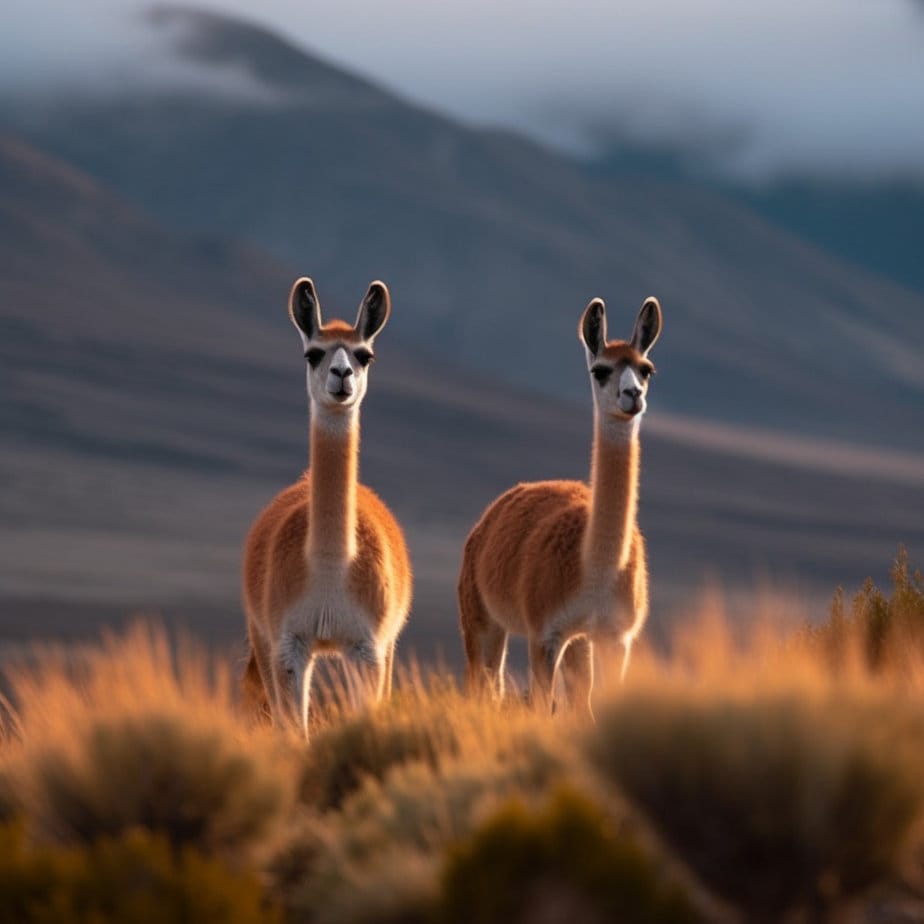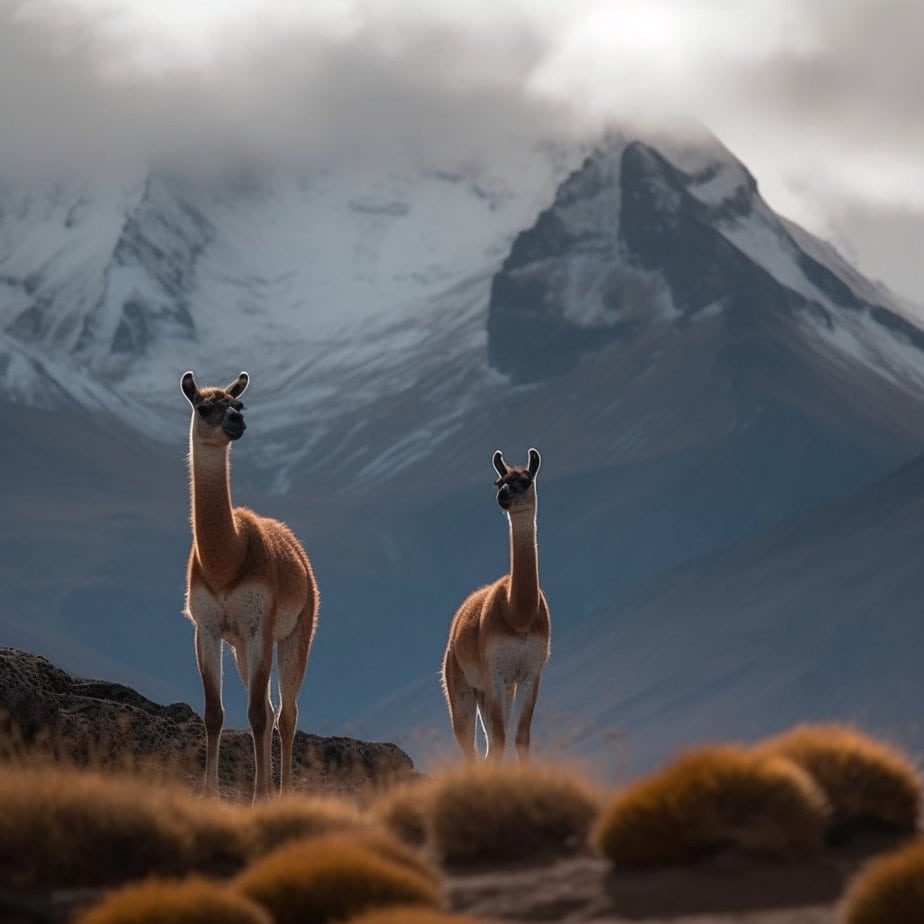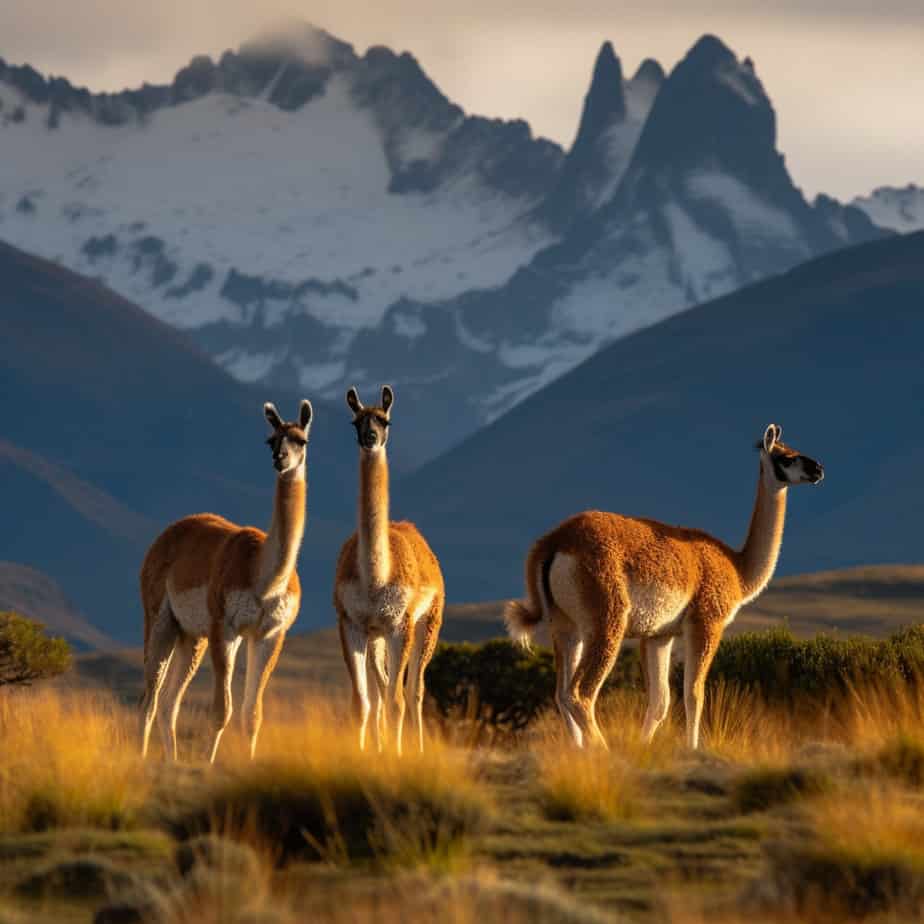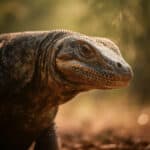Guanacos, the majestic camelids native to South America, are fascinating creatures that roam the vast open plains and rugged mountains of the region. These herbivorous animals have adapted to survive in harsh environments, but they are not without their share of predators. In this article, we will explore the various predators that pose a threat to guanacos and delve into their hunting techniques and behaviors. From the stealthy puma to the cunning Andean fox, guanacos must constantly be on guard to ensure their survival in the wild. So, let’s embark on this journey to discover the predators of guanacos and gain a deeper understanding of the delicate balance of nature in which they exist.
Key Takeaways
- Guanacos, a type of camelid native to South America, have several natural predators.
- The main predators of guanacos include pumas, foxes, and wild dogs.
- Predation on guanacos can have significant impacts on their population dynamics and behavior.
- Conservation efforts are important to protect guanacos and maintain the balance of their ecosystems.
Understanding the Guanaco: A Brief Overview

The guanaco (Lama guanicoe) is a fascinating and unique animal that inhabits the rugged landscapes of South America. In this section, we will delve into the guanaco‘s habitat and distribution, as well as its diet and lifestyle.
A. Guanaco’s Habitat and Distribution
Guanacos are native to the Andean regions of South America, including countries such as Argentina, Chile, Peru, and Bolivia. These majestic creatures have adapted to survive in some of the harshest environments on the planet.
1. Habitat
Guanacos are well-suited to thrive in diverse habitats, ranging from high-altitude grasslands to arid deserts. They are particularly abundant in the Patagonian steppe, where the vast open spaces provide them with ample grazing opportunities. These herbivores are also known to inhabit the Andean plateaus and mountainous regions, where they navigate steep slopes and rocky terrains with ease.
2. Distribution
Guanacos have a wide distribution across South America. They can be found in various ecosystems, including the Andean highlands, the Pampas grasslands, and even the coastal regions. However, their populations are most concentrated in the southern regions of the continent, particularly in Argentina and Chile.
B. Guanaco’s Diet and Lifestyle
Guanacos are herbivores, primarily feeding on a diet of grasses, shrubs, and lichens. Their ability to extract nutrients from sparse vegetation allows them to survive in environments where other animals would struggle.
1. Diet
Guanacos have a unique digestive system that enables them to efficiently process tough and fibrous plant material. They have a three-chambered stomach, similar to other members of the camelid family, which helps break down the cellulose in their diet. This adaptation allows them to extract maximum nutrition from the vegetation they consume.
2. Lifestyle
Guanacos are social animals that typically live in herds, known as “harems,” consisting of a dominant male, several females, and their offspring. These herds provide safety in numbers and allow for cooperative defense against predators. Guanacos communicate through a variety of vocalizations, including alarm calls to alert the group of potential threats.
In addition to their social structure, guanacos have developed various defense mechanisms to protect themselves from predators. When threatened, they can reach speeds of up to 35 miles per hour (56 kilometers per hour) to escape their pursuers. They are also known to use their powerful hind legs to kick predators, such as pumas or foxes, as a means of defense.
Overall, guanacos play a vital role in the ecosystems they inhabit. As herbivores, they contribute to the balance of plant populations and serve as a food source for predators higher up the food chain. Their ability to adapt to harsh environments and their unique behavioral and physical adaptations make them a truly remarkable species.
In the next section, we will explore the predators that pose a threat to guanacos and the survival tactics they employ to evade them. Stay tuned for an in-depth look at the intricate relationship between guanacos and their natural enemies.
Guanacos and Predation: An Inherent Threat

Guanacos, the majestic camelids native to South America, face a constant threat from predators in their natural habitat. These herbivorous animals, known for their slender bodies and long necks, must constantly be on guard against a variety of predators that seek to make them their next meal. In this section, we will explore the predation process and the impact it has on guanaco populations.
A. The Predation Process: How Predators Hunt Guanacos
Predators in South America have adapted various strategies to hunt guanacos. One of the most formidable predators of guanacos is the puma, also known as the cougar or mountain lion. Pumas are stealthy hunters that rely on their agility and strength to bring down their prey. They often target young, weak, or injured guanacos, using their powerful jaws to deliver a fatal bite to the neck.
Guanacos, however, are not defenseless. They have developed several survival tactics to evade predation. One of their primary defense mechanisms is their exceptional speed and agility. Guanacos can reach speeds of up to 35 miles per hour, allowing them to outrun many predators. They also have a keen sense of hearing and sight, which helps them detect approaching threats from a distance.
Another interesting defense mechanism of guanacos is their ability to spit. When threatened, guanacos may expel stomach contents, creating a foul-smelling spray that can deter predators. This behavior is more commonly observed when guanacos are threatened by other guanacos during territorial disputes, but it can also be used as a defense mechanism against predators.
B. The Impact of Predation on Guanaco Populations
Predation plays a crucial role in shaping guanaco populations and maintaining a healthy ecosystem. While predation can have a negative impact on individual guanacos, it helps regulate population sizes and ensures the survival of the fittest. By preying on weaker individuals, predators contribute to the overall health and genetic diversity of guanaco populations.
However, excessive predation can pose a threat to guanaco populations, especially when their habitat is fragmented or disturbed. Human activities such as habitat destruction, poaching, and competition for resources can exacerbate the impact of predation on guanacos. In some regions, guanacos face additional threats from introduced predators, such as foxes and dogs, which can have a significant impact on their populations.
It is important to strike a balance between predator-prey dynamics and conservation efforts to ensure the long-term survival of guanacos. By protecting their natural habitat, implementing measures to reduce human-wildlife conflict, and managing predator populations responsibly, we can help safeguard the future of these iconic South American animals.
In conclusion, predation is an inherent threat to guanacos, but they have evolved remarkable defense mechanisms to survive in the face of danger. Understanding the predation process and its impact on guanaco populations is crucial for conservation efforts and maintaining the delicate balance of ecosystems in which they thrive.
The Puma: Guanaco’s Primary Predator
A. Puma’s Hunting Techniques: A Threat to Guanacos
The puma, also known as the cougar or mountain lion, is the primary predator of guanacos in South America. These large, solitary cats are highly skilled hunters, capable of taking down prey much larger than themselves. Let’s take a closer look at the hunting techniques employed by pumas and how they pose a threat to guanacos.
Pumas are ambush predators, relying on stealth and surprise to catch their prey. They have a remarkable ability to blend into their surroundings, thanks to their tawny fur that provides excellent camouflage in the grassy plains and rocky terrains where guanacos roam. With their powerful hind legs, they can leap up to 20 feet in a single bound, allowing them to pounce on unsuspecting guanacos from a distance.
Once a puma has spotted a guanaco, it will slowly stalk its prey, keeping a low profile and moving silently. Pumas are patient hunters, waiting for the perfect moment to strike. When the time is right, they will launch a lightning-fast attack, aiming to deliver a fatal bite to the neck or throat of the guanaco. Their sharp teeth and strong jaws enable them to quickly incapacitate their prey.
B. The Puma-Guanaco Interaction: A Survival Struggle
The interaction between pumas and guanacos is a constant struggle for survival. Guanacos have evolved several defense mechanisms to increase their chances of escaping a puma‘s attack. When a guanaco senses danger, it will emit a loud alarm call, alerting other members of the herd to the potential threat. This collective warning system allows guanacos to stay vigilant and ready to flee at a moment’s notice.
Guanacos are also incredibly agile and can reach impressive speeds of up to 35 miles per hour when running. This speed, combined with their ability to navigate challenging terrains, gives them an advantage in evading pumas. They will often seek refuge in rocky areas or dense vegetation, where their larger predators struggle to maneuver effectively.
Despite their best efforts, guanacos still fall victim to puma attacks. Pumas are opportunistic hunters and will target weaker or injured individuals within a herd. Young guanacos are particularly vulnerable, as they lack the experience and strength to defend themselves effectively. Pumas play a crucial role in regulating guanaco populations, ensuring a healthy balance within the ecosystem.
In conclusion, the puma is the primary predator of guanacos in South America. With their stealthy hunting techniques and powerful physical abilities, pumas pose a significant threat to guanaco populations. However, guanacos have developed survival tactics such as alarm calls, agility, and seeking refuge in challenging terrain to increase their chances of escaping a puma‘s attack. The interaction between pumas and guanacos is a constant struggle for survival, shaping the delicate balance of the ecosystem they inhabit.
Other Predators of the Guanaco

A. Birds of Prey: An Aerial Threat to Guanacos
Guanacos, being herbivores, may not seem like an obvious target for birds of prey. However, these majestic creatures are not immune to the threat of aerial predators. In the vast open landscapes where guanacos roam, birds of prey play a significant role in the ecosystem by preying on smaller animals, including guanaco calves or weakened individuals.
-
Andean Condor: The Andean condor, with its impressive wingspan of up to 10 feet, is one of the most iconic birds of prey in South America. These scavengers are opportunistic hunters and can pose a threat to guanaco calves or injured adults. With their keen eyesight and powerful beaks, they can easily spot and target vulnerable guanacos.
-
Chimango Caracara: Another bird of prey commonly found in the guanaco‘s habitat is the chimango caracara. These medium-sized raptors are known for their scavenging behavior but are also skilled hunters. They have been observed preying on young guanacos or individuals weakened by illness or injury.
To protect themselves from these aerial threats, guanacos have developed various defense mechanisms. They are highly vigilant and have excellent eyesight, allowing them to detect potential predators from a distance. When a guanaco senses danger, it emits a loud alarm call, alerting other members of the herd to be on high alert.
B. Canine Predators: Foxes and Wild Dogs in the Guanaco Predation Scene
In addition to birds of prey, guanacos also face threats from terrestrial predators, particularly canines. Foxes and wild dogs are known to target guanacos, especially when they are vulnerable, such as during the birthing season or when individuals are weakened by illness or injury.
-
Culpeo Fox: The culpeo fox, also known as the Andean fox, is a native predator found in the guanaco‘s habitat. These foxes are opportunistic hunters and have been observed preying on guanaco calves. With their agility and speed, culpeo foxes can easily chase down young guanacos or exploit any weakness in the herd’s defense.
-
Feral Dogs: Unfortunately, feral dogs have become a significant threat to guanacos in certain regions. These dogs, which have gone wild or been abandoned by humans, form packs and can cause significant damage to guanaco populations. Feral dogs are highly adaptable and have been known to hunt guanacos, especially when they are in a weakened state.
To survive in the face of these canine predators, guanacos rely on their strong herding instincts. When they sense danger, guanacos gather together, forming a tight-knit group that makes it difficult for predators to single out an individual. Additionally, guanacos have the ability to run at high speeds, allowing them to escape from predators that may be pursuing them.
In conclusion, guanacos face a range of predators in their natural environment. Birds of prey, such as the Andean condor and chimango caracara, pose an aerial threat to guanacos, particularly the young and vulnerable. Canine predators, including culpeo foxes and feral dogs, also target guanacos, especially during times of weakness. However, guanacos have evolved various defense mechanisms, such as their keen senses, alarm calls, herding behavior, and speed, to increase their chances of survival in the face of these threats. By understanding the dynamics between guanacos and their predators, we can better appreciate the delicate balance of nature in South America’s diverse ecosystems.
Guanaco’s Defensive Mechanisms against Predators
A. Physical Defenses: Speed, Strength, and Stamina
Guanacos, the majestic camelids native to South America, have evolved various defensive mechanisms to protect themselves against their natural enemies. One of their primary physical defenses is their remarkable speed, strength, and stamina. These attributes enable guanacos to outmaneuver and escape from potential predators.
Guanacos are incredibly agile and can reach speeds of up to 35 miles per hour (56 kilometers per hour). Their long legs and slender bodies allow them to cover vast distances quickly, making it challenging for predators to catch them. When threatened, guanacos rely on their exceptional speed to outrun their pursuers and seek safety in open spaces or challenging terrains where predators may struggle to keep up.
In addition to their speed, guanacos possess impressive strength. Adult guanacos can weigh between 200 to 300 pounds (90 to 140 kilograms), and their muscular bodies contribute to their defensive capabilities. When confronted by a predator, guanacos may use their strength to deliver powerful kicks with their hind legs, capable of inflicting severe injuries. These kicks can be a formidable deterrent, often dissuading predators from pursuing a guanaco further.
Furthermore, guanacos have exceptional stamina, allowing them to sustain their speed and endurance over long distances. This endurance is crucial when evading predators, as guanacos may need to outrun them for extended periods. Their ability to maintain a swift pace for an extended time gives them a significant advantage in escaping potential threats.
B. Social Defenses: The Role of Herd Behavior in Guanaco Survival
Guanacos are highly social animals, and their herd behavior plays a vital role in their survival. Living in herds provides guanacos with several advantages when it comes to defending against predators.
Firstly, the sheer number of individuals in a guanaco herd acts as a deterrent to predators. Predators, such as pumas or foxes, are less likely to attack a large group of guanacos due to the increased risk of injury or failure in capturing a meal. The collective strength and vigilance of the herd make it challenging for predators to single out and target a specific guanaco.
Secondly, guanacos exhibit a fascinating behavior known as “mobbing.” When a predator approaches, guanacos will gather together and form a defensive circle around their young, creating a united front against the threat. This behavior not only provides physical protection but also confuses and intimidates the predator, making it less likely to launch an attack.
Additionally, guanacos communicate through vocalizations and body language, allowing them to alert the herd of potential dangers. When one guanaco detects a predator, it will emit a loud alarm call, signaling the rest of the herd to be on high alert. This coordinated response helps ensure the safety of the entire group.
In conclusion, guanacos employ a combination of physical and social defenses to protect themselves against predators. Their remarkable speed, strength, and stamina enable them to outrun and fend off attackers, while their herd behavior provides safety in numbers and facilitates collective defense. These survival tactics have allowed guanacos to thrive in their natural habitats, contributing to the delicate balance of the South American ecosystem.
The Impact of Human Activity on Guanaco Predation
A. Habitat Loss: Increasing the Threat of Predation
Habitat loss is a significant factor that has a direct impact on the predation of guanacos. As human activity continues to encroach upon their natural habitats, guanacos face increased vulnerability to predators. The expansion of agriculture, urbanization, and infrastructure development has resulted in the destruction and fragmentation of their habitats, leaving guanacos with limited space to roam and find food.
When guanacos lose their natural habitats, they are forced to venture into areas closer to human settlements, where they are more exposed to predation. This displacement disrupts their natural behavior and puts them at a higher risk of encountering predators. Additionally, habitat loss reduces the availability of suitable vegetation for guanacos to feed on, further weakening their ability to defend themselves against predators.
B. Hunting: Humans as Guanaco Predators
While guanacos have natural predators in the wild, they also face the threat of predation from humans. Historically, guanacos have been hunted for their meat, fur, and other valuable resources. Indigenous communities in South America have relied on guanaco hunting for sustenance and cultural practices for centuries. However, with the growth of commercial hunting and illegal poaching, the guanaco population has been significantly impacted.
Unregulated hunting poses a severe threat to guanaco populations, as it disrupts the delicate balance of their ecosystem. Overhunting can lead to a decline in guanaco numbers, affecting the overall health of the population and the ecosystem they inhabit. Conservation efforts and strict regulations are necessary to ensure the sustainable management of guanaco hunting and prevent further population decline.
It is important to note that not all human activity negatively impacts guanaco populations. In some cases, conservation organizations and local communities work together to protect guanaco habitats and implement sustainable hunting practices. These efforts aim to strike a balance between human needs and the preservation of guanaco populations.
In conclusion, human activity plays a significant role in the predation of guanacos. Habitat loss due to urbanization and agriculture increases their vulnerability to natural predators, while unregulated hunting poses a direct threat to their population. It is crucial for us to recognize the impact of our actions on these magnificent creatures and work towards sustainable practices that ensure their survival in the wild.
Conservation Efforts: Protecting Guanacos from Predators
Guanacos, the majestic camelids native to South America, face numerous threats from predators in their natural habitat. To ensure the survival of these beautiful creatures, various conservation efforts have been implemented. This section will explore two key strategies employed to protect guanacos from their predators: legal protections and hunting regulations, as well as habitat restoration and predator control.
A. Legal Protections and Hunting Regulations
Recognizing the importance of preserving guanaco populations, several countries in South America have implemented legal protections and hunting regulations. These measures aim to regulate human activities that may pose a threat to guanacos and their habitats.
1. Protected Status
Guanacos are classified as protected species in many countries, including Argentina, Chile, and Peru. This designation prohibits the hunting, capturing, or killing of guanacos without proper permits or licenses. By granting them protected status, governments aim to safeguard guanaco populations and prevent their decline.
2. Hunting Regulations
In countries where guanaco hunting is permitted, strict regulations are in place to ensure sustainable practices. These regulations typically include limits on the number of guanacos that can be hunted, specific hunting seasons, and licensing requirements. By implementing these measures, authorities can monitor and control hunting activities, preventing overexploitation of guanaco populations.
B. Habitat Restoration and Predator Control
Another crucial aspect of guanaco conservation is habitat restoration and predator control. These strategies focus on creating and maintaining suitable habitats for guanacos while managing predator populations to minimize predation.
1. Habitat Restoration
Habitat loss and degradation pose significant threats to guanacos. To counteract these issues, conservation organizations and government agencies work together to restore and protect guanaco habitats. This involves initiatives such as reforestation, erosion control, and the establishment of protected areas. By restoring and preserving their natural habitats, guanacos have a better chance of thriving and avoiding predators.
2. Predator Control
Predators, such as pumas, foxes, and birds of prey, pose a constant threat to guanacos. To mitigate predation, predator control programs are implemented in certain areas. These programs aim to manage predator populations through methods such as trapping, relocation, or, in extreme cases, culling. By reducing predator numbers, the risk to guanacos is minimized, allowing them to flourish in their habitats.
In conclusion, protecting guanacos from predators requires a multi-faceted approach. Legal protections and hunting regulations ensure that guanacos are not subjected to excessive hunting pressure, while habitat restoration and predator control efforts create a safer environment for these magnificent creatures. By implementing these conservation strategies, we can help safeguard guanacos and ensure their continued presence in the South American ecosystem. Conclusion
In conclusion, guanacos, the wild camelids native to South America, face a variety of predators in their natural habitat. These predators include pumas, foxes, and domestic dogs. Pumas, being the top predators in the region, pose the greatest threat to guanacos, especially to the young and weak individuals. Foxes, on the other hand, primarily target guanaco calves. Domestic dogs, when not properly controlled, can also pose a significant risk to guanacos, as they may chase and attack them. Despite these challenges, guanacos have developed various adaptations to evade their predators, such as their exceptional speed and agility. Additionally, their herding behavior helps in detecting and avoiding potential threats. Understanding the predators of guanacos is crucial for their conservation, as it allows us to implement effective strategies to protect these magnificent creatures and ensure their survival in the wild.
Frequently Asked Questions
1. What are the natural enemies of guanacos?
Guanacos’ natural enemies include pumas, foxes, and certain birds of prey. These predators are native to the South American regions where guanacos live.
2. How does the puma hunt guanacos?
Pumas, being one of the primary predators of guanacos, typically use stealth and surprise tactics to hunt. They approach their prey silently and then pounce with a powerful leap to secure their meal.
3. What are the defense mechanisms of guanacos?
Guanacos have several defense mechanisms to protect themselves from predators. They have excellent hearing and sight which helps them detect predators from a distance. When threatened, they can run at high speeds and navigate difficult terrain to escape.
4. What are the survival tactics of guanacos?
Guanacos use a variety of survival tactics, including living in herds for protection, running at high speeds to escape predators, and having the ability to survive in harsh climates and terrains.
5. Are guanacos considered prey in the food chain?
Yes, guanacos are considered prey in the food chain. They are herbivores that graze on grasses and shrubs, and they are hunted by predators like pumas, foxes, and certain birds of prey.
6. How do foxes and birds of prey interact with guanacos?
Foxes and birds of prey are both predators of guanacos. While foxes may target younger or weaker individuals, large birds of prey can swoop down and attack both young and adult guanacos.
7. What are the threats to guanacos?
Threats to guanacos include natural predators like pumas, foxes, and birds of prey. They are also threatened by human activities such as hunting and habitat loss due to agriculture and urbanization.
8. How do guanacos contribute to the ecosystem?
Guanacos play a vital role in the ecosystem by serving as prey for various predators. They also help in the dispersal of seeds through their droppings, contributing to plant biodiversity.
9. What is the typical habitat of guanacos?
Guanacos typically inhabit the arid plains and mountainous regions of South America, including the Andes mountains and the Patagonian steppe.
10. What are the Andean mountain predators that pose a threat to guanacos?
The primary predator of guanacos in the Andean mountains is the puma. Other potential threats could include foxes and certain species of birds of prey.




